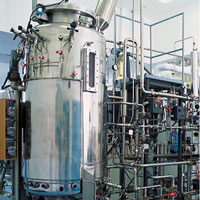|
There are four types or combinations of pharmaceuticals that are manufactured. They are bulk products, intermediate products, active ingredients and FDA-approved drug products. Bulk pharmaceuticals and intermediates are often made by fine chemical companies.
Crystallization/Evaporation
Crystallization is accomplished by evaporation and cooling of a supersaturated liquid to form crystals. These crystals are easy to handle, store, and are sold in this finished form. NASH vacuum pumps are ideal for controlling the evaporation/cooling rates across all pressure ranges to reduce production cost by lowering the boiling point of the liquid. |
 |
Degassing
Degassing is the removal of dissolved/trapped gases from a liquid or product. Vacuum created by the NASH liquid ring pump allows the vapor to be removed from the liquid. This improves the product's physical characteristics to allow further processing, and thus avoiding cross contamination and corrosion.
The following is a brief list of applications:
| • | Degassing oils to improve purity (hydrocarbon oil, transformer oil, turbine oil, brake fluid, hydraulic brake oil, etc.) | |
| • | Degassing glues, pastes, paints to remove unwanted gases that would harden or degrade the product | |
| • | Degassing polymers in an extruder to obtain a higher quality product or bubble free sheet | |
| • | Degassing water for medical, food and boilers. |
Distillation
Distillation is the separation of two or more distinct layers or zones, which differ in temperature, pressure, composition or phase state. As the tower moves to equilibrium, each zone will have a different concentration, and thus, can be separated from the original mixture. Simply put, the distillation column provides an atmosphere where each liquid component can separate from another by changing the vacuum and temperature.
The vacuum system removes the non-condensable load, water and light ends from the system allowing the feedstock to be processed through the column to achieve separation. The gas removed from the top of the tower is condensed, and the liquids are reintroduced into the tower for further separation. Typically used on fatty acids, monoglycerides, vitamins (A,E), oils, esters, paraffins, insecticides, plasticizers, etc.
Drying (Tray, Rotary, Tumble, Conical & Freeze Dryers)
Drying is a low cost, relatively low temperature process where the biological or active ingredient is not harmed/degraded/oxidized by pulling vacuum to evaporate liquids from the solids. Pharmaceutical/Biological products are dried to remove solvents, water, etc. and typically require a vacuum below 1 torr in the final drying stage. The remaining cake is granulated, blended, and pressed into pills. The low residual moisture levels make the product useful for longer term storage.
Filling and/or Transfer of Material
Creams and pastes require removal of air when filling tubes, etc. This is accomplished with small liquid ring pumps located on the filling machine. Liquid transfer occurs by using a vacuum pump to fill the tank and then discharge it via a compressor. This is accomplished with NASH liquid ring vacuum pumps.
Reactors/Reactor Drying
Reactors are used in fine chemical, pharmaceutical and fragrance industries. The vacuum is used to reduce/control the temperature of the reaction, remove reacted products, reduce cost, control/improve product quality, and recapture product. There is a wide array of chemical processes suitable for using liquid ring pump technology. These include: pharmaceutical intermediates, chemical reactions for neutralization and adsorption, stripping/cracking of hydrocarbons and other chemicals, and synthesis of chemical compounds.



